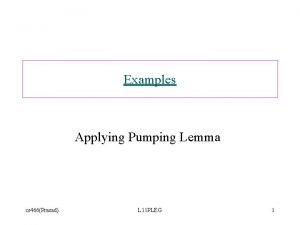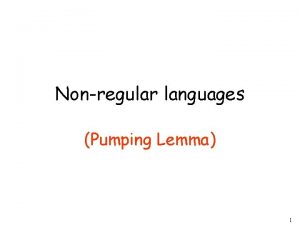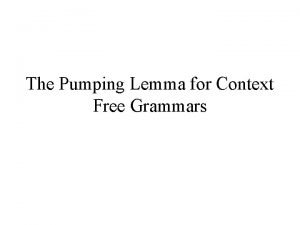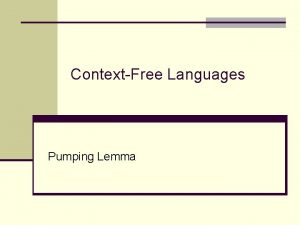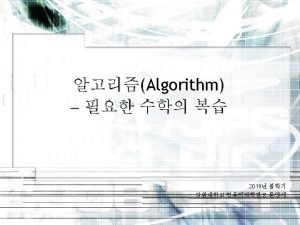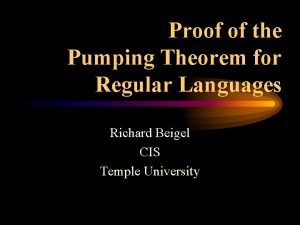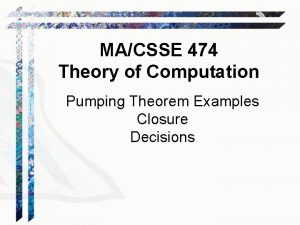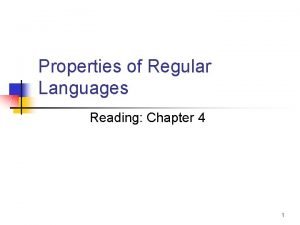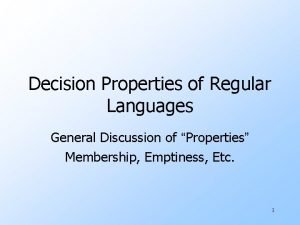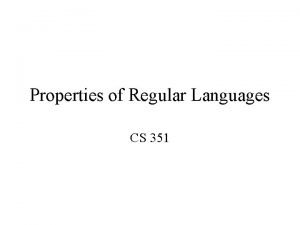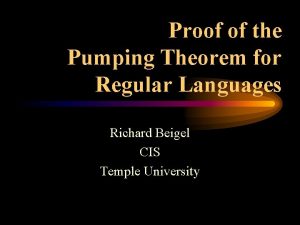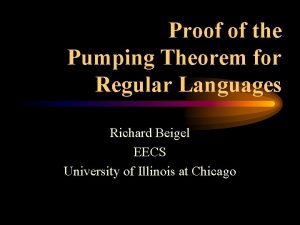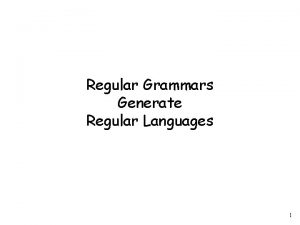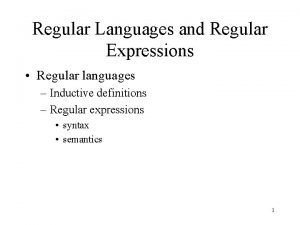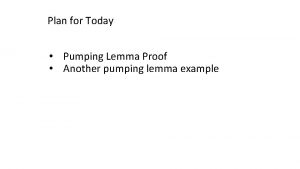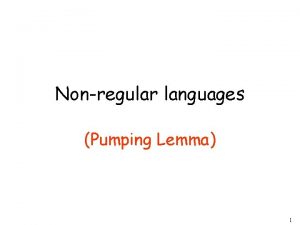Proof of the Pumping Theorem for Regular Languages













- Slides: 13

Proof of the Pumping Theorem for Regular Languages Richard Beigel CIS Temple University

The Pumping Theorem for Regular Languages If L is regular then N z such that z L and |z| N u, v, w such that z = uvw , |uv| N, and |v| > 0 i [uviw L]

Proof • Assume L is regular • Then there is a (standardized) DFR P that recognizes L (no EOF or NOOP) • Let be N be the number of control states in P • Let z L and |z| N • Consider P’s accepting computation on input z • Let q 0, q 1, …, qn be the sequence of control states in that computation. Then n N.

Proof • Then there is a standardized DFR P that recognizes L (no EOF or NOOP) • Let be N be the number of control states in P • Let z L and |z| N • Consider P’s accepting computation on input z • Let q 0, q 1, …, qn be the sequence of control states in that computation. Then n N. • By the pigeonhole principle qj=qk for some j<k

Proof • • Let be N be the number of control states in P Let z L and |z| N Consider P’s accepting computation on input z Let q 0, q 1, …, qn be the sequence of control states in that computation. Then n N. • By the pigeonhole principle qj=qk for some j<k • Let u be the string scanned between q 0 and qj

Proof • Let z L and |z| N • Consider P’s accepting computation on input z • Let q 0, q 1, …, qn be the sequence of control states in that computation. Then n N. • By the pigeonhole principle qj=qk for some j<k • Let u be the string scanned between q 0 and qj • Let v be the string scanned between qj and qk

Proof • Consider P’s accepting computation on input z • Let q 0, q 1, …, qn be the sequence of control states in that computation. Then n N. • By the pigeonhole principle qj=qk for some j<k • Let u be the string scanned between q 0 and qj • Let v be the string scanned between qj and qk • Let w be the string scanned between qk and qn

Proof • Let q 0, q 1, …, qn be the sequence of control states in that computation. Then n N. • By the pigeonhole principle qj=qk for some j<k • Let u be the string scanned between q 0 and qj • Let v be the string scanned between qj and qk • Let w be the string scanned between qk and qn • Then uvw = z, |uv| N, |v| 1, • and P accepts uviw for all i 0

Proof • • By the pigeonhole principle qj=qk for some j<k Let u be the string scanned between q 0 and qj Let v be the string scanned between qj and qk Let w be the string scanned between qk and qn Then uvw = z, |uv| N, |v| 1, and P accepts uviw for all i 0 Therefore uviw L for all i 0, completing the proof of the Pumping

qj = qk Picture-proof that uv*w L v q 0 u qj w qn

Example: L = • • 2 n {a : n 0} Assume L is regular Let N be given by the Pumping Theorem Let z = a. N 2 Let u, v, w be given by the Pumping Theorem Then v = ak where 0 < k N Let i = 2 Then uviw = uv 2 w = uvvw = a. N 2 + k Since N 2 < N 2 + k N 2 + N < N 2 + 2 N + 1 = (N + 1)2, N 2 + k is not a square, so uviw = a. N 2 + k L • This contradicts the Pumping Theorem, so L is not regular

Example: L = • • • m n {a b : m n} Assume L is regular Let N be given by the Pumping Theorem Let z = a. N b. N Let u, v, w be given by the Pumping Theorem Then v = ak where 0 < k N Let i = 2 Then uviw = uvvw = a. N+k b. N Since k > 0, N+k > N, so uviw = a. N+k b. N L This contradicts the Pumping Theorem, so L is not regular

Example: L = • • • m n {a b : m n} Assume L is regular Let N be given by the Pumping Theorem Let z = a. N b. N Let u, v, w be given by the Pumping Theorem Then v = ak where 0 < k N Let i = 0 Then uviw = uw = a. N-k b. N Since k > 0, N-k < N, so uviw = a. N-k b. N L This contradicts the Pumping Theorem, so L is not regular
 Proof by contradiction examples
Proof by contradiction examples Pumping lemma non regular languages examples
Pumping lemma non regular languages examples Regular grammars generate regular languages.
Regular grammars generate regular languages. Chomsky
Chomsky Pumping lemma for cfls
Pumping lemma for cfls Pumping lemma proof
Pumping lemma proof Pumping theorem
Pumping theorem Pumping theorem
Pumping theorem Green to stokes
Green to stokes Closure properties of regular expression
Closure properties of regular expression Right linear grammar to left linear grammar
Right linear grammar to left linear grammar Decision properties of regular languages
Decision properties of regular languages Decision properties of regular languages
Decision properties of regular languages Decision properties of regular languages
Decision properties of regular languages
